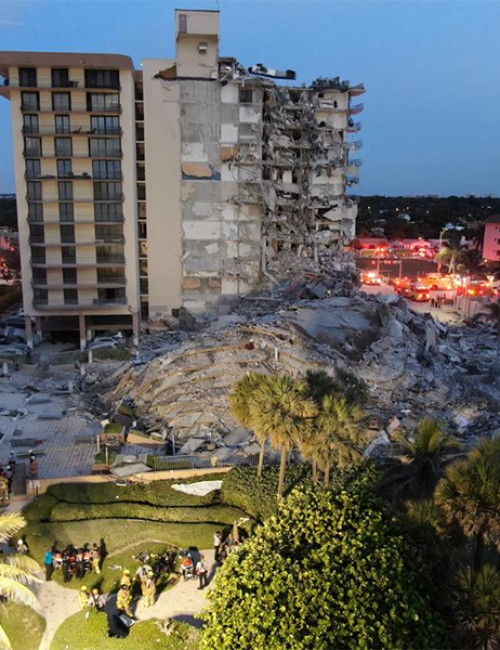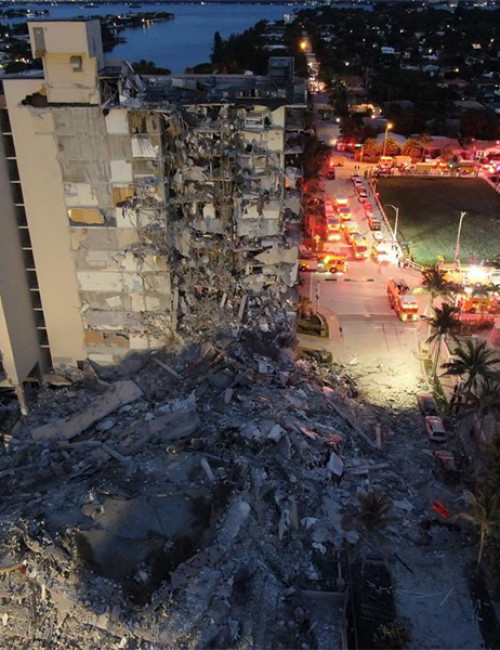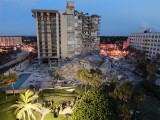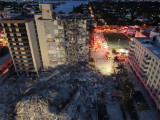Champlain Towers South
Surfside
- Facts
-
Metrics
You must be a CTBUH Member to view this resource.
Official Name
Champlain Towers South
Name of Complex
Type
Building
Status
Demolished
Completion
1981
Country
City
Address
Function
A mixed-use tall building contains two or more functions (or uses), where each of the functions occupy a significant proportion of the tower's total space. Support areas such as car parks and mechanical plant space do not constitute mixed-use functions. Functions are denoted on CTBUH "Tallest Building" lists in descending order, e.g., "hotel/office" indicates hotel function above office function.
Residential
Structural Material
Both the main vertical/lateral structural elements and the floor spanning systems are constructed from steel. Note that a building of steel construction with a floor system of concrete planks or concrete slab on top of steel beams is still considered an “all-steel” structure as the concrete elements are not acting as the primary structure.
All-Concrete
Both the main vertical/lateral structural elements and the floor spanning systems are constructed from concrete which has been cast in place and utilizes steel reinforcement bars and/or steel reinforced concrete which has been precast as individual components and assembled together on-site.
All-Timber
Both the main vertical/lateral structural elements and the floor spanning systems are constructed from timber. An all-timber structure may include the use of localized non-timber connections between timber elements. Note that a building of timber construction with a floor system of concrete planks or concrete slab on top of timber beams is still considered an “all-timber” structure as the concrete elements are not acting as the primary structure.
Mixed-Structure
Utilizes distinct systems (e.g. all-steel, all-concrete, all-timber), one on top of the other. For example, a Steel Over Concrete indicates an all-steel structural system located on top of an all-concrete structural system, with the opposite true of Concrete Over Steel.
Composite
A combination of materials (e.g. steel, concrete, timber) are used together in the main structural elements. Examples include buildings which utilize: steel columns with a floor system of reinforced concrete beams; a steel frame system with a concrete core; concrete-encased steel columns; concrete-filled steel tubes; etc. Where known, the CTBUH database breaks out the materials used within a composite building’s primary structural elements.
All-Concrete
Height
43 m / 141 ft
Floors Above Ground
13
Construction Schedule
Proposed
Completed
Demolished
You must be a CTBUH Member to view this resource.
Architect
Usually involved in the front end design, with a "typical" condition being that of a leadership role through either Schematic Design or Design Development, and then a monitoring role through the CD and CA phases.
William M. Friedman & Associates Architects, Inc.
Structural Engineer
The Design Engineer is usually involved in the front end design, typically taking the leadership role in the Schematic Design and Design Development, and then a monitoring role through the CD and CA phases.
Breiterman Jurado & Associates, Consulting Engineers
Other Consultant
Other Consultant refers to other organizations which provided significant consultation services for a building project (e.g. wind consultants, environmental consultants, fire and life safety consultants, etc).
Other Consultant refers to other organizations which provided significant consultation services for a building project (e.g. wind consultants, environmental consultants, fire and life safety consultants, etc).
Controlled Demolition, Inc.; The BG Group, LLC
Global News

08 March 2024
Origins of Surfside High-Rise Collapse Still Point to Pool Deck
A federal probe into the June 2021 collapse of a Surfside condo tower that left 98 people dead continues to point to the building’s pool...
Global News

08 March 2024
Origins of Surfside High-Rise Collapse Still Point to Pool Deck
A federal probe into the June 2021 collapse of a Surfside condo tower that left 98 people dead continues to point to the building’s pool...

19 May 2022
Surfside Condo Collapse Tentative Settlement Reaches Nearly US$1 Billion
A nearly US$1 billion tentative settlement has been reached in a class-action lawsuit brought by families of victims and survivors of June’ 2021's condominium collapse...
210630-050603.jpg)
16 August 2021
Modeling Explores How the Surfside Condo Collapse Could Have Occurred
Investigation continues into the cause of the collapse of the Champlain Towers South building in Surfside, which collapsed on June 24, killing 98 people. The...

06 July 2021
Surfside Building Demolished to Aid Search Efforts
The death toll has risen to 28 with 117 people still missing at the site of the collapsed Champlain Towers South building in Surfside. The...
Subscribe below to receive periodic updates from CTBUH on the latest Tall Building and Urban news and CTBUH initiatives, including our monthly newsletter. Fields with a red asterisk (*) next to them are required.
View our privacy policy




